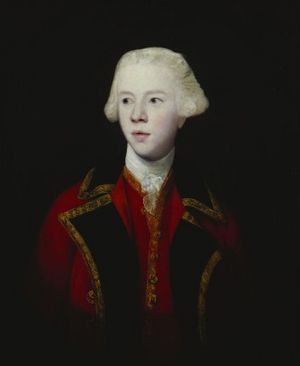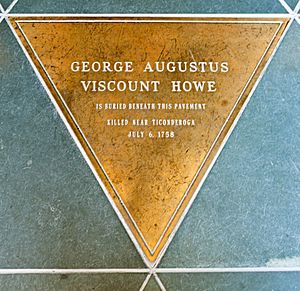George Howe, 3rd Viscount Howe facts for kids
Quick facts for kids
Viscount Howe
|
|
|---|---|

George Augustus, 3rd Viscount Howe, Half-Length, Wearing the Uniform of the 55th Foot, by Sir Joshua Reynolds
|
|
| Born | c. 1725 London, England |
| Died | 6 July 1758 (aged 32–33) Ticonderoga, New York |
| Allegiance | |
| Service/ |
British Army |
| Years of service | 1745-1758 |
| Rank | Brigadier general |
| Battles/wars | |
George Augustus Howe, 3rd Viscount Howe (born around 1725 – died July 6, 1758), was a brave officer and a brigadier general in the British Army. He was known as one of the best officers of his time. He sadly died during the French and Indian War near Fort Ticonderoga. This happened just before a big battle where the British tried to capture the French-controlled Fort Carillon.
Contents
Who Was George Howe?
George Augustus Howe was born around 1725. His father was Emanuel Scrope Howe, 2nd Viscount Howe. His mother was Mary Sophia von Kielmansegg, who was a niece of King George I. George had two famous younger brothers, Richard Howe and William Howe. He was born either at his family's home in Langar, Nottinghamshire, or in London.
Early Life and Military Start
George Howe joined the army in 1745 as an ensign (a junior officer) in the Grenadier Guards. He served in a war called the War of the Austrian Succession. In 1746, he became an aide-de-camp (a personal assistant) to the Duke of Cumberland, who led the Allied Army. Howe fought in the Battle of Laufeld in 1747. After the war ended, he was promoted to lieutenant colonel in 1749.
Changing the Army's Look and Tactics
In 1758, the British planned to attack a French fort called Ticonderoga. This fort was very important because it controlled the way from Lake George to Lake Champlain. Lord Howe decided to make big changes to General James Abercrombie's army. He wanted them to be ready for fighting in North America.
Uniform Makeovers
Howe used his own 55th Regiment as an example for the rest of the army. He had their uniforms cut shorter, so they only reached their waists. All the fancy lace was removed from their coats. The soldiers' big, three-cornered hats (called tricorn hats) were cut down to have small brims, looking more like derby hats. Soldiers were given wool leggings instead of their old linen and hemp gaiters (leg coverings). Extra uniforms and equipment were taken away. The men's hair was cut short, making them look very different.
Howe also set an example for the officers. He cut his own hair short, washed his own clothes, and carried very little luggage when they went into the field.
New Ways to Fight in the Woods
Howe's changes were not just about uniforms; they were also about how the army fought. In 1757, he went on a scouting trip with a famous ranger named Major Robert Rogers. He met with Rogers again to learn about fighting in North America.
Howe then started teaching Abercrombie's soldiers how to march, form up, and fight in the woods. One person said that Howe trained his 55th Regiment so well that they were as "dexterious as rangers." This means they were as skilled as the special ranger units.
Some people say Lord Howe created light infantry. Light infantry are soldiers who move quickly and fight in a less formal way. While his changes were important, the first British light infantry regiment was actually Gage's 80th Regiment. They wore brown uniforms instead of red. Later, other generals also created light infantry companies in their regiments.
The Battle of Ticonderoga
In 1757, Howe was made a colonel of the 60th Foot regiment. Then, in September 1757, he took command of the 55th Regiment of Foot. In December, he was promoted to Brigadier General.
In 1758, Howe and his regiment were part of General James Abercrombie's attack on Fort Ticonderoga. This attack was known as the Battle of Carillon. England's Prime Minister, William Pitt, actually wanted Howe to lead this mission. However, Abercrombie had more political connections and was older, so Howe became the second-in-command.
On July 6, Abercrombie's army marched north from Lake George. Howe led one of the columns, with his 55th regiment and some soldiers from Connecticut. Major Israel Putnam was their scout. They met a French group that had gotten separated from their main force. A quick fight happened. Howe's men fought well, capturing 148 prisoners and causing about 300 French casualties. They had few losses themselves. But sadly, General Howe was one of those casualties. He died in Major Putnam's arms.
A Hero Remembered

People on both sides of the Atlantic Ocean were very sad about Howe's death. The Massachusetts Assembly later voted to pay £250 for a monument to him. This monument was placed in Westminster Abbey in 1759. It was made by the sculptor Peter Scheemakers.
George Augustus Howe was the brother of Admiral Richard Howe and Sir William Howe. These brothers were later chosen to lead British forces in the American Revolutionary War. People thought they could help make peace with the American forces because they were friendly to the colonies.

